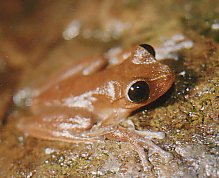
Litoria is a genus of hylid tree frogs native to Australia, the Bismarck Archipelago, the Solomon Islands, New Guinea, the Lesser Sunda Islands, and the Moluccan Islands. It is the only genus in the monotypic subfamily Litoriinae and are sometimes collectively referred to as Australasian treefrogs. They are distinguishable from other tree frogs by the presence of horizontal irises, no pigmentation of the eyelids, and their distribution east and south from Wallacea. Over 90 species are described, but several new species are described every year on average, such as the Pinocchio frog, discovered in 2008 and described in 2019.

Nyctimystes is a genus of tree frogs in the subfamily Pelodryadinae of the family Hylidae. They are principally Papuan species, but also inhabit islands in the Moluccas. All species in this genus have one distinct feature that separates them from other species in the family, the lower eyelid is marked with pattern of lines, veins, or dots. This feature presumably acts as camouflage when the frogs are at rest during the day.

The Australian green tree frog, also known as simply green tree frog in Australia, White's tree frog, or dumpy tree frog, is a species of tree frog native to Australia and New Guinea, with introduced populations in the United States and New Zealand, though the latter is believed to have died out. It is morphologically similar to some other members of its genus, particularly the magnificent tree frog (R. splendida) and the white-lipped tree frog (R. infrafrenata).
Litoria singadanae is a species of small green tree frogs reaching 35mm in length. It has long back legs, extensive webbing on the fingers and a prominent tympanum.

Roth's tree frog or the northern laughing tree frog is a tree frog native to northern Australia and southern Papua New Guinea. Roth's tree frog is a common frog, closely related to Peron's tree frog and Tyler's tree frog.
Djoko Tjahjono Iskandar is an Indonesian herpetologist who studies the amphibians of Southeast Asia and Australasia. He is a professor of biosystematics and ecology at Bandung Institute of Technology in West Java, Indonesia.
The Pinocchio frog or northern Pinocchio treefrog is a species of frog in the subfamily Pelodryadinae. It was discovered in the Foja Mountains of Papua Province in Indonesia by Conservation International and the National Geographic Society during a 2008 expedition, where it was accidentally spotted by Paul Oliver, a herpetologist. Despite being discovered in 2008, it remained undescribed and was long known simply as the "Pinocchio frog" until 2019, when it was finally described as Litoria pinocchio. The frog is named for its Pinocchio-like nose, which can enlarge and inflate in certain situations. Although unusual, a similar nose is found in several other related frogs from New Guinea, including L. chrisdahli, L. havina, L. mareku, L. mucro, L. pronimia and L. prora.
Litoria chrisdahli is a species of frogs in the subfamily Pelodryadinae. It is endemic to Papua New Guinea.
Litoria hilli is a species of frog in the subfamily Pelodryadinae. It is endemic to the Tagula Island of Papua New Guinea.
Nyctimystes purpureolatus is a species of frog in the subfamily Pelodryadinae. It is endemic to New Guinea and is known from its type locality on the Tiri River, a small tributary of the Mamberamo River in West Papua, Indonesia, and from three locations in West Sepik Province, Papua New Guinea.
Litoria spartacus is a species of frogs in the subfamily Pelodryadinae of the family Hylidae. It is endemic to New Guinea in Papua New Guinea and is only known from two localities within the Kikori Integrate Conservation and Development Project Area in the Southern Highlands Province. It has affinities to Litoria macki and Litoria spinifera but has a smaller size and more extensively webbed hands and less tuberculate body.

Chocolate frog is a tree frog belonging to the genus Litoria, and is part of the Litoria caerulea species complex. It was discovered in New Guinea by a research team led by Griffith University. It was named mira because of the surprising nature of the discovery, its chocolate-brown skin.
The montane Pinocchio frog is a frog from the island of New Guinea. Scientists saw it on Hides Ridge in the karstic area of the Southern Fold Mountains in Papua New Guinea. Like the Pinocchio frog, it has a protuberance on its snout that can grow or shrink.
Mareku's tree frog is a frog in the family Hylidae. It is endemic to Indonesia. Scientists have seen it in the Wondiwoi Mountains in Papua Province.
Litoria hunti is a tree frog in the family Hylidae. It is endemic to northern Papua New Guinea. The New Guineans call it "Wowo." Scientists have only seen it in Utai, which is in Sanduan Province, but they think it lives in many other places on the island of New Guinea.
Litoria gasconi is a frog in the subfamily Pelodryadinae. It is endemic to Indonesia and Papua New Guinea.
Litoria chloristona is a frog in the subfamily Pelodryadinae. It is endemic to Papua New Guinea. Scientists have observed it near the Kikori River, from sea level to 500 meters above sea level. The type locality is Port Essington in Australia.
Litoria sauroni is a tree frog in the subfamily Pelodryadinae. It is endemic to Papua New Guinea. Scientists know it solely from the Kikori Integrate Conservation and Development Project area. Scientists disagree about whether this frog is best placed in the genus Litoria or Nyctimystes.
Litoria eurynastes is a frog in the subfamily Pelodryadinae, endemic to Papua New Guinea. It resembles Litoria bicolor, but it is larger.
Litoria viranula is a frog in the family Hylidae, endemic to Papua New Guinea and Indonesia. It is in the same species group with Litoria bicolor.





